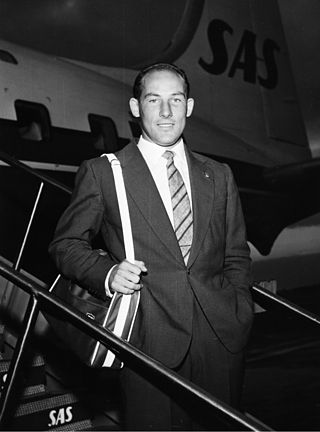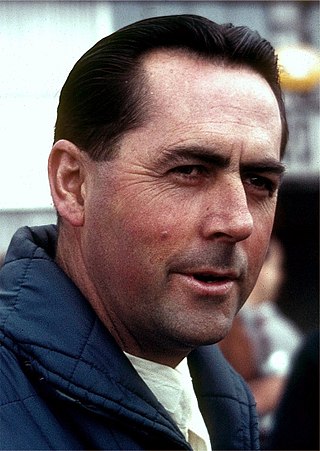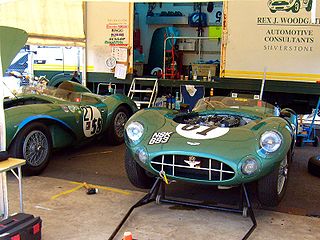Aston Martin Lagonda Global Holdings PLC is a British manufacturer of luxury sports cars and grand tourers. Its predecessor was founded in 1913 by Lionel Martin and Robert Bamford. Steered from 1947 by David Brown, it became associated with expensive grand touring cars in the 1950s and 1960s, and with the fictional character James Bond following his use of a DB5 model in the 1964 film Goldfinger. Their grand tourers and sports cars are regarded as a British cultural icon.

Sir Stirling Craufurd Moss was a British Formula One driver. An inductee into the International Motorsports Hall of Fame, he won 212 of the 529 races he entered across several different motorsports competitions and has been described as "the greatest driver never to win the Formula One World Championship". In a seven-year span between 1955 and 1961, Moss finished in second place four times and in third place three times.

Formula Two is a type of open-wheel formula racing category first codified in 1948. It was replaced in 1985 by Formula 3000, but revived by the FIA from 2009–2012 in the form of the FIA Formula Two Championship. The name returned again in 2017 when the former GP2 Series became known as the FIA Formula 2 Championship.

The 1960 Formula One season was the 14th season of FIA Formula One motor racing. It featured the 11th World Championship of Drivers, the third International Cup for F1 Manufacturers and five non-championship Formula One races. The World Championship was contested over ten races between 7 February and 20 November 1960.

Roy Francesco Salvadori was a British racing driver and team manager. He was born in Dovercourt, Essex, to parents of Italian descent. He graduated to Formula One by 1952 and competed regularly until 1962 for a succession of teams including Cooper, Vanwall, BRM, Aston Martin and Connaught. Also a competitor in other formulae, he won the 1959 24 Hours of Le Mans in an Aston Martin with co-driver Carroll Shelby.

Hersham and Walton Motors (HWM) is the world's longest established Aston Martin business, having acquired the franchise in 1951. As a racing car constructor, HWM competed in Formula One and Formula Two, and in sports car racing.

JBW Cars was a British racing car manufacturer in the late 1950s, who were a Formula One constructor from 1959 to 1961.

Reginald Parnell was a racing driver and team manager from Derby, England. He participated in seven Formula One World Championship Grands Prix, achieving one podium, and scoring a total of nine championship points.

The DB4 is a grand tourer that was produced by Aston Martin from 1958 until 1963. The "DB" designation came from Sir David Brown, who built up the company from 1947 onwards.

The World Sportscar Championship was the world series run for sports car racing by the FIA from 1953 to 1992. The championship evolved from a small collection of the most important sportscar, endurance, and road racing events in Europe and North America with dozens of gentleman drivers at the grid to a professional racing series where the world's largest automakers spent millions of dollars per year.

The 1960 24 Hours of Le Mans was the 28th 24 Hours of Le Mans Grand Prix of Endurance, and took place on 25 and 26 June 1960, on Circuit de la Sarthe. It was the fifth and final round of the F.I.A. World Sports Car Championship as well as being the fifth round of the inaugural FIA GT Cup. It was held just a week after the tragic Belgian F1 GP in which two drivers were killed and Stirling Moss and another driver were seriously injured. The prospect of a duel between the 3-litre (180 cu in) Ferrari versus the 2-litre (120 cu in) Porsche championship-leaders was enough to draw large crowds to the 24 Hours race and some 200,000 spectators had gathered for Europe's classic sports car race, around the 13.5 km (8.4 mi) course.

The 1959 24 Hours of Le Mans was the 27th 24 Hours of Le Mans, Grand Prix of Endurance, and took place on 20 and 21 June 1959, on Circuit de la Sarthe. It was also the fourth round of the F.I.A. World Sports Car Championship. The prospect of an exciting duel between Ferrari, Aston Martin and giantkillers Porsche was enough to draw large crowds and some 150,000 spectators gathered for France's classic sports car race, around the 8.38-mile course.

The Aston Martin DBR1 is a sports racing car built by Aston Martin starting in 1956, intended for the World Sportscar Championship as well as non-championship sportscar races at the time. It is most famous as the victor of the 1959 24 Hours of Le Mans, Aston Martin's only outright victory at the endurance classic. It is one of only three cars in the 1950s to win both the World Sports Car Championship and Le Mans 24 Hours in the same year. In addition the six World Sports Car Championship victories was a record for any car in the 1950s and remained a record in the championship until surpassed by the Ferrari 250TR. The three consecutive triumphs in 1959 at the Nürburgring, Le Mans and the Tourist Trophy equalled the record set by the Ferrari 250TR with its three consecutive victories at the start of the 1958 season.

A V8 engine is an eight-cylinder piston engine in which two banks of four cylinders share a common crankshaft and are arranged in a V configuration.

The Aston Martin DBR4/250, commonly referred to simply as the DBR4, is a Formula One racing car, designed by Ted Cutting for the sports car manufacturer Aston Martin. Following notable successes in sports car racing during the mid- to late-1950s — culminating in winning the 24 Hours of Le Mans endurance race and the World Sportscar Championship title in 1959 — the DBR4 was intended to repeat this success in the highest tier of open-wheel racing.

Aston Martin Racing is a British auto racing team established in 2004 as a partnership between automobile manufacturer Aston Martin and engineering group Prodrive. The partnership was initially created for the purpose of returning Aston Martin to sports car racing with the DBR9, a heavily modified variant of the Aston Martin DB9. Since the DBR9's racing debut in 2005, Aston Martin Racing has expanded to build a variety of cars available to customers, as well as development of Aston Martin's V12 engine for Le Mans Prototype use. Aston Martin Racing's program has earned several successes over the years.

The 1960 Australian Grand Prix was a motor race held at Lowood in Queensland, Australia on 12 June 1960. The race, which was run to Formula Libre, had 16 starters.
Edward John 'Ted' Cutting was a British automotive engineer. He designed the body, engine, chassis, suspension and fully engineered the Aston Martin DBR1, winner of the 1959 24 Hours of Le Mans.

Aston Martin is a British car manufacturer that has participated in Formula One in various forms and is currently represented by a team named as Aston Martin Aramco F1 Team. The company first participated in Formula One during the 1959 season, where they debuted the DBR4 chassis using their own engine, but it failed to score any points. They continued to perform poorly through the 1960 season, once again failing to score any points. As a result, Aston Martin decided to leave Formula One after 1960.
The Aston Martin RB6 is a 2.5-litre, naturally-aspirated, inline-6 racing engine, developed and designed by Aston Martin for Formula One racing; used between 1959 and 1960. The RB6 also shared the basic double-overhead camshaft straight-6 Aston Martin engine design with its brethren, but sleeved to reduce its capacity to 2.5-litres. Although Tadek Marek's design was a reliable and powerful unit in its 3.7-litre road car form, the reduced capacity racing motor was hard-pressed to cope with the heavy chassis and poor aerodynamics, and frequent engine failures blighted the DBR4's brief racing career. Aston Martin claimed a 280 bhp (210 kW) output for the DBR4's engine. However, it was common practice at the time to overquote engine power, and a more realistic value is closer to 250 bhp (190 kW). This value is still higher than that provided by the Coventry Climax FPF straight-4, used by contemporary manufacturers such as Lotus and Cooper, but the Aston Martin engine weighed appreciably more. The engine drove the rear wheels through a proprietary David Brown gearbox, provided by Aston Martin's owners.















